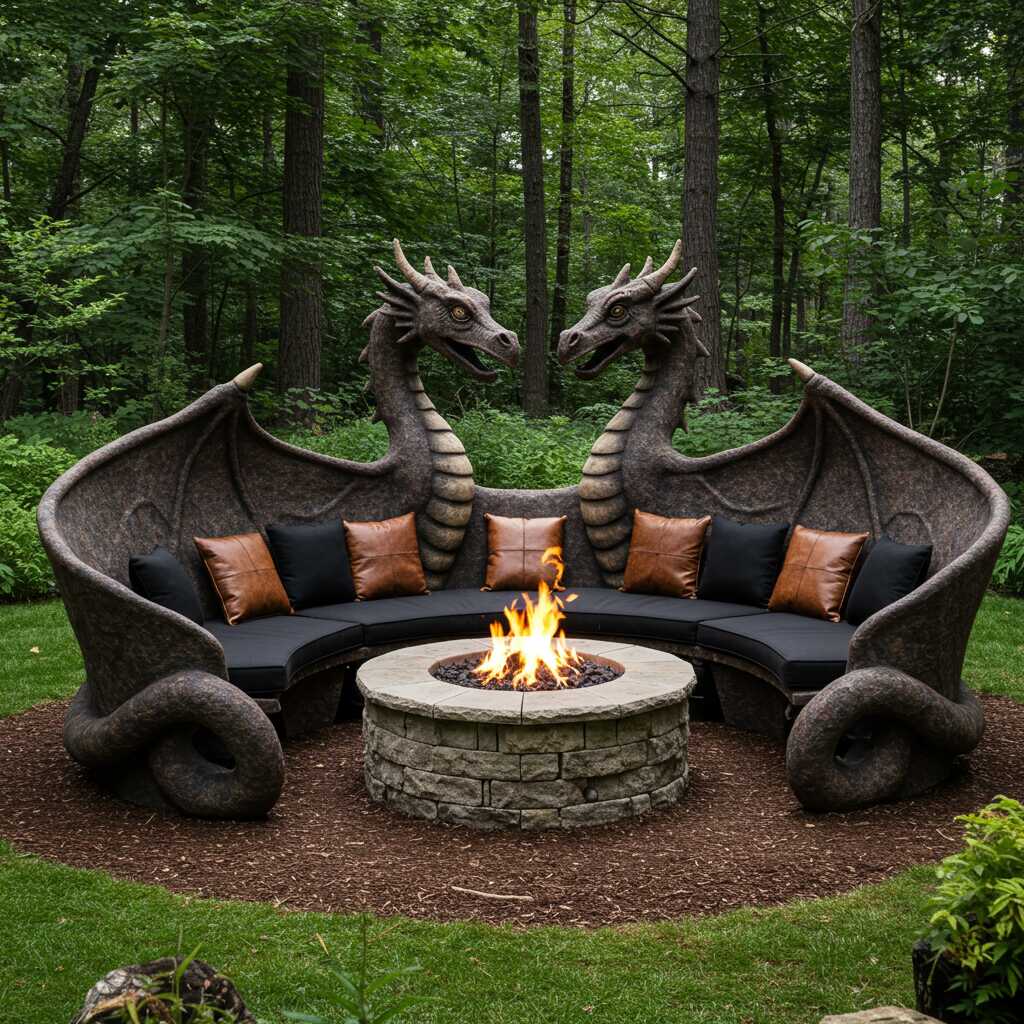In an era where the boundaries between nature and technology are increasingly blurred, innovative designs that fuse the organic with the artificial have captured the imagination of creative minds and eco-conscious individuals alike. Among these remarkable creations, the concept of an “Aquarium Integrated With Tree Trunk” stands out as a breathtaking example of how natural beauty can harmonize with human ingenuity. These unique installations transform the traditional aquarium into a living work of art, blending aquatic life with the rugged elegance of a tree trunk. This article delves into the captivating allure of this design, exploring its aesthetic, ecological, and philosophical significance. From the intricate craftsmanship required to create such pieces to their ability to inspire a deeper connection with the natural world, tree trunk aquariums exemplify the seamless meeting point of nature and innovation.
The journey of discovering these extraordinary aquariums begins with their visual appeal. Imagine a hollowed-out tree trunk, its weathered bark preserving the essence of centuries past, now cradling a vibrant underwater ecosystem. Fish dart gracefully through the water, while plants sway gently in rhythm with the currents, all encased within the organic frame of the trunk. The juxtaposition of the aquatic world with the enduring strength of wood creates a striking visual contrast, drawing viewers into a contemplative space where time seems to slow. Beyond aesthetics, these aquariums also serve as a bridge between two seemingly disparate realms: the terrestrial and the aquatic. By integrating elements of both, they invite us to reconsider our relationship with the environment and appreciate the interconnectedness of life on Earth.
This exploration will unfold in three parts, each shedding light on a different facet of the “Aquarium Integrated With Tree Trunk.” First, we will delve into the artistic fusion of natural materials and modern design, examining how these aquariums embody creativity and craftsmanship. Next, we will explore their ecological implications, highlighting their role in fostering biodiversity and promoting sustainable practices. Finally, we will reflect on the deeper philosophical questions these installations raise about humanity’s place in the natural world. Together, these sections will paint a comprehensive picture of why tree trunk aquariums are not just decorative objects but profound statements about the harmony that can exist between nature and innovation.
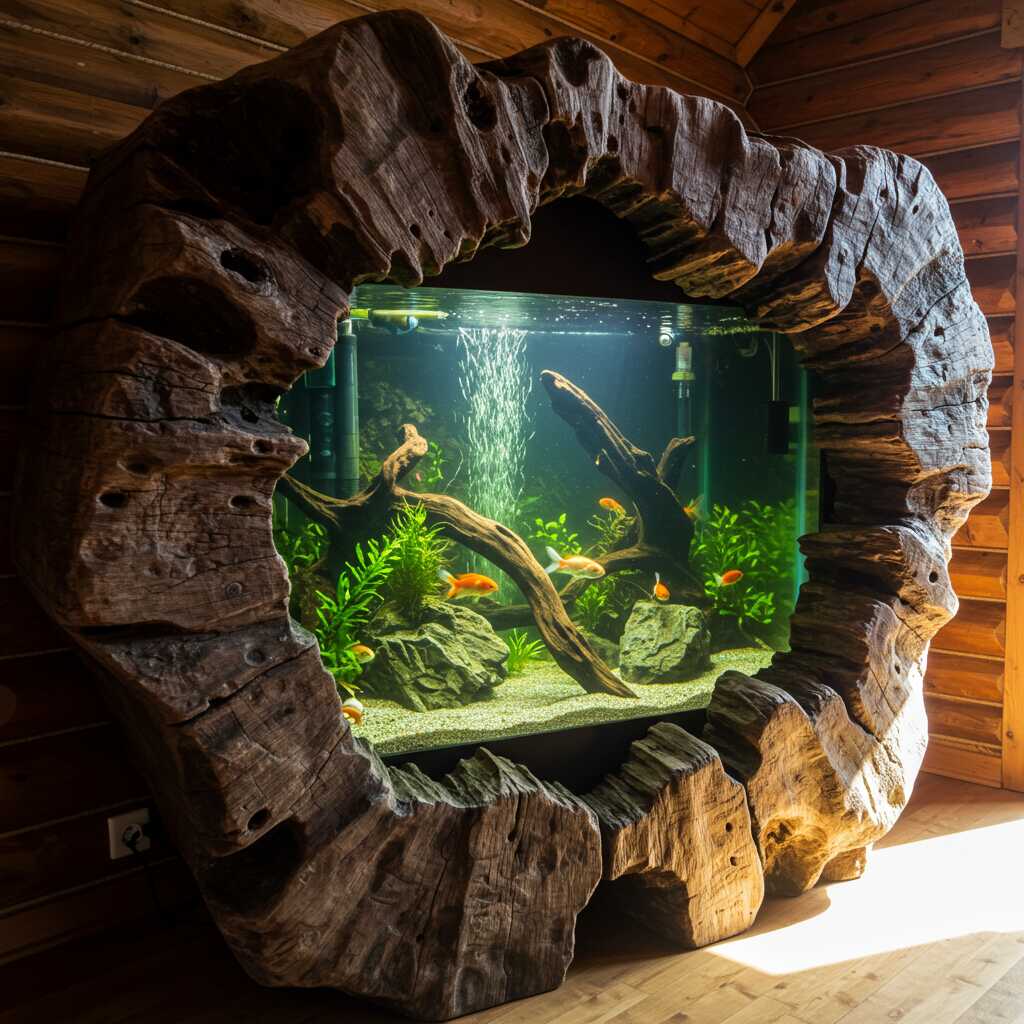
The Artistic Fusion: Blending Nature and Design in Tree Trunk Aquariums
At the heart of every “Aquarium Integrated With Tree Trunk” lies a masterful blend of raw natural beauty and meticulous design craftsmanship. These aquariums are more than functional habitats for aquatic life—they are living sculptures that celebrate the inherent artistry of both nature and human ingenuity. The process of creating such a piece begins with the careful selection of a tree trunk, often chosen for its unique grain patterns, texture, and history etched into its surface. Each trunk carries the story of its environment, from the weathering effects of wind and rain to the scars left by insects or time. This organic canvas serves as the foundation upon which designers weave their vision, ensuring that the final product remains deeply rooted in the authenticity of the natural world.
Once the trunk is selected, artisans employ a combination of traditional woodworking techniques and modern engineering to prepare it for its new purpose. Hollowing out the core without compromising the structural integrity of the trunk requires precision and respect for the material. The result is a vessel that retains the rugged charm of the original tree while seamlessly accommodating the technical demands of an aquarium. Glass panels are often integrated into the design, allowing for unobstructed views of the aquatic life within. These transparent surfaces not only enhance the visual experience but also symbolize the transparency of nature itself—revealing the hidden wonders of underwater ecosystems to those who pause to observe.
What sets these aquariums apart is their ability to evoke a sense of wonder through contrasts. The rough, textured exterior of the tree trunk juxtaposed against the smooth clarity of the glass and the fluid movements of aquatic life creates a dynamic interplay of textures and forms. Inside, the vibrant colors of fish and aquatic plants bring the installation to life, transforming what was once a static piece of wood into a dynamic tableau of movement and color. The trunk’s natural imperfections—knots, grooves, and uneven edges—are not flaws but features that add character and depth, reminding viewers of the imperfect yet beautiful cycles of growth and decay in nature.
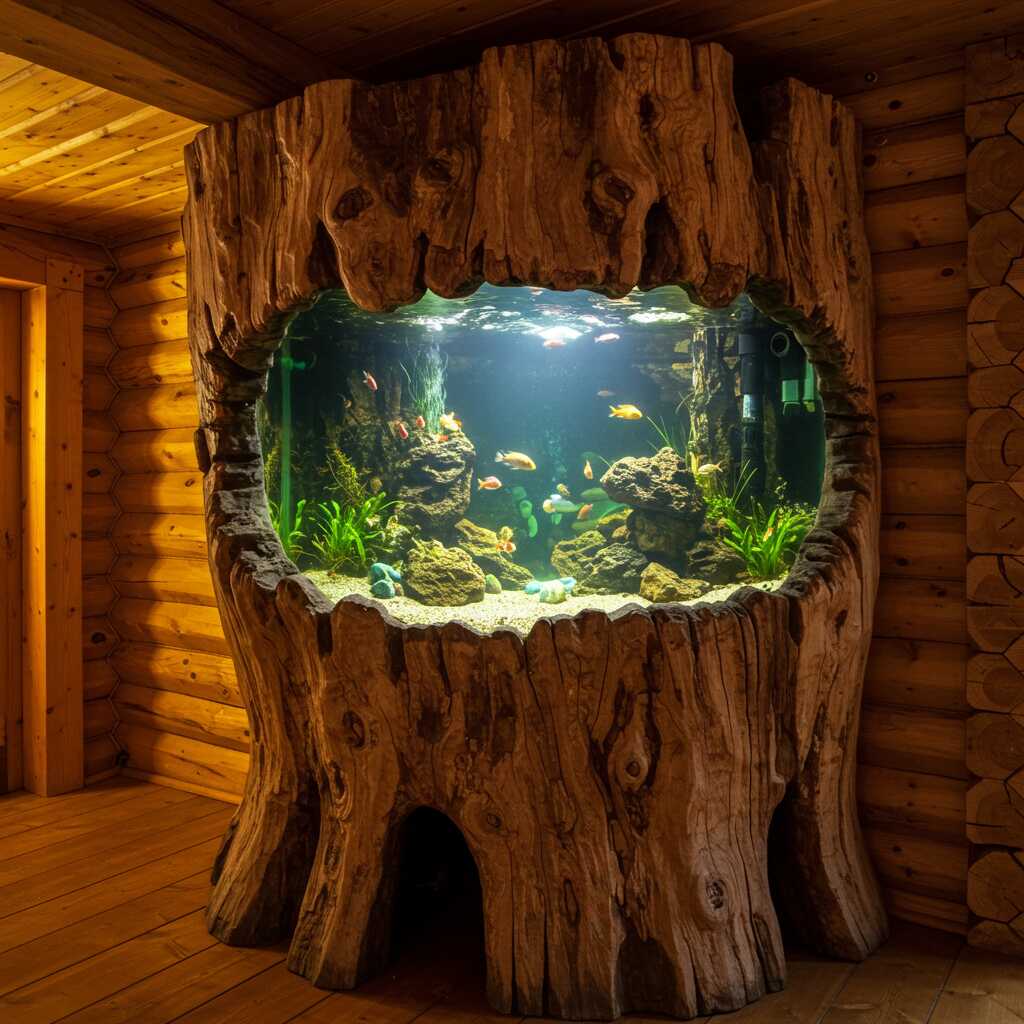
Moreover, the design of these aquariums often incorporates elements that echo the surrounding environment. For instance, moss or lichen might be allowed to grow on the exterior of the trunk, blurring the line between the installation and its natural setting. In some cases, lighting is strategically placed to highlight the intricate details of the wood or mimic the dappled sunlight filtering through a forest canopy. These thoughtful touches elevate the aquarium beyond a mere object of decoration, turning it into an immersive experience that invites reflection and appreciation for the delicate balance of art and nature.
Ultimately, the “Aquarium Integrated With Tree Trunk” represents a celebration of the creative possibilities that arise when humans collaborate with nature rather than impose upon it. It is a testament to the idea that innovation does not have to come at the expense of the natural world; instead, it can honor and amplify its beauty. Through their artful integration of organic and designed elements, these aquariums challenge conventional notions of what an aquarium can be, offering a glimpse into a world where nature and design coexist in perfect harmony.
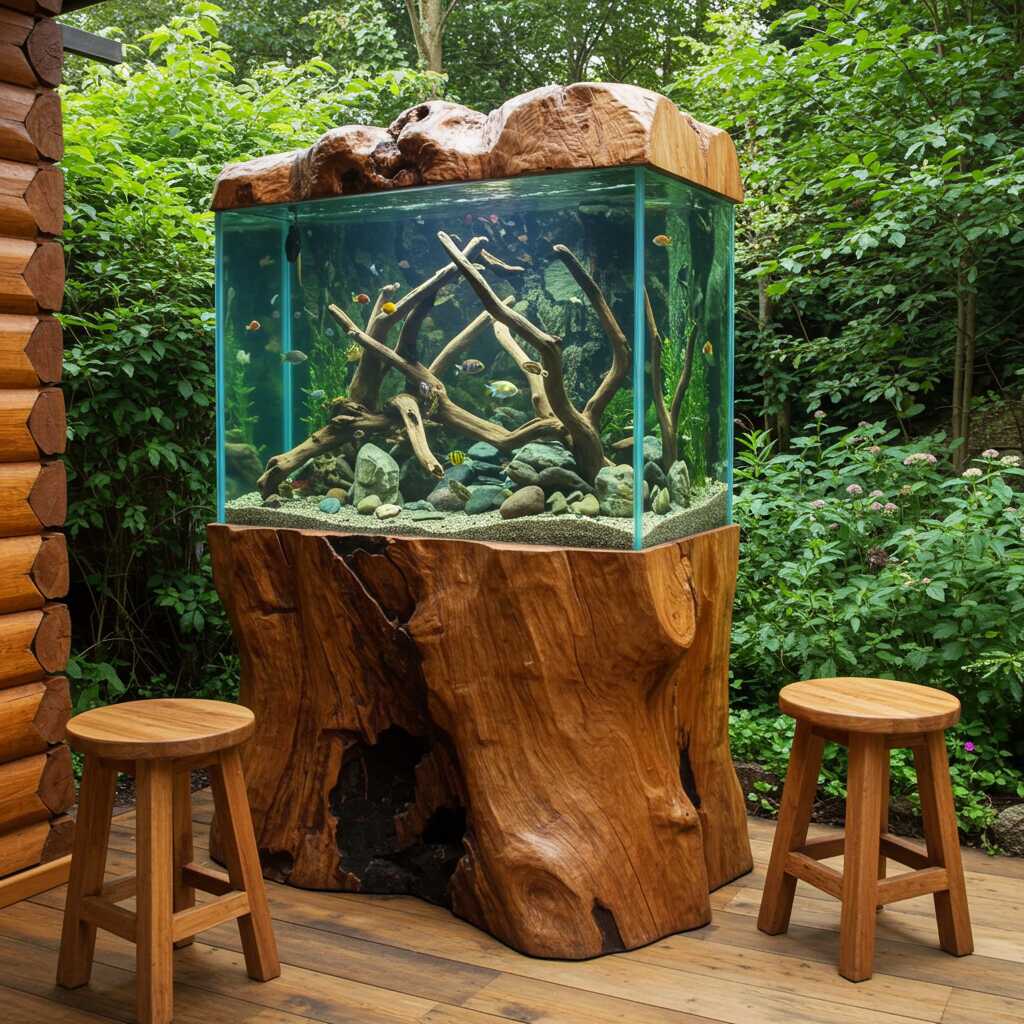
Ecological Harmony: The Environmental Significance of Tree Trunk Aquariums
Beyond their aesthetic allure, “Aquariums Integrated With Tree Trunks” hold profound ecological value, serving as microcosms of biodiversity and sustainability. These installations are not merely decorative; they function as miniature ecosystems that emulate the intricate balance of life found in nature. By combining terrestrial and aquatic elements, they create environments where flora and fauna thrive together, offering a tangible reminder of the interconnectedness of all living systems. The tree trunk itself—a relic of the forest—becomes a sanctuary for aquatic organisms, while also providing a habitat for terrestrial species that may interact with its exterior. This duality underscores the potential of such designs to foster biodiversity and promote environmental stewardship.
One of the most compelling aspects of these aquariums is their ability to replicate natural habitats. The hollowed-out trunk mimics the fallen logs and submerged trees often found in rivers, lakes, and wetlands, which serve as vital shelters for fish, amphibians, and invertebrates. Within the confines of the aquarium, these microhabitats support diverse aquatic life, from algae-eating snails and shrimp to small fish species that rely on the structure for shelter and breeding. Plants rooted in the substrate further enhance the ecosystem, contributing oxygen through photosynthesis and creating niches for smaller organisms. This symbiotic relationship mirrors the processes found in wild aquatic environments, where every element plays a role in maintaining ecological equilibrium.
Moreover, the use of reclaimed or sustainably sourced tree trunks aligns with principles of environmental responsibility. Rather than harvesting live trees, artisans often repurpose fallen or dead wood, giving new life to materials that would otherwise decompose or go to waste. This practice not only reduces the ecological footprint of the installation but also honors the lifecycle of the tree, ensuring that its legacy continues in a meaningful way. Additionally, the integration of native aquatic plants and species can enhance the sustainability of these aquariums, as they require fewer resources and are better adapted to local conditions. By prioritizing such considerations, these designs demonstrate how human creativity can harmonize with ecological principles to create lasting value.
The educational potential of tree trunk aquariums is another significant aspect of their ecological impact. They serve as living laboratories, offering opportunities to observe and understand the delicate relationships within ecosystems. For instance, viewers can witness firsthand how plants purify water, how fish contribute to nutrient cycling, and how even the smallest organisms play essential roles in maintaining balance. This hands-on engagement fosters a deeper appreciation for the complexity of natural systems and encourages a mindset of conservation. By bringing these processes into view, tree trunk aquariums inspire a sense of responsibility toward the environment, motivating individuals to adopt more sustainable practices in their own lives.
In essence, the “Aquarium Integrated With Tree Trunk” transcends its role as a decorative piece, becoming a powerful advocate for ecological awareness and biodiversity. It embodies the idea that innovation can coexist with sustainability, offering a model for how humans can interact with nature in ways that are both respectful and regenerative. Through their ability to nurture life, reduce waste, and educate, these aquariums exemplify the profound potential of design to contribute positively to the environment.
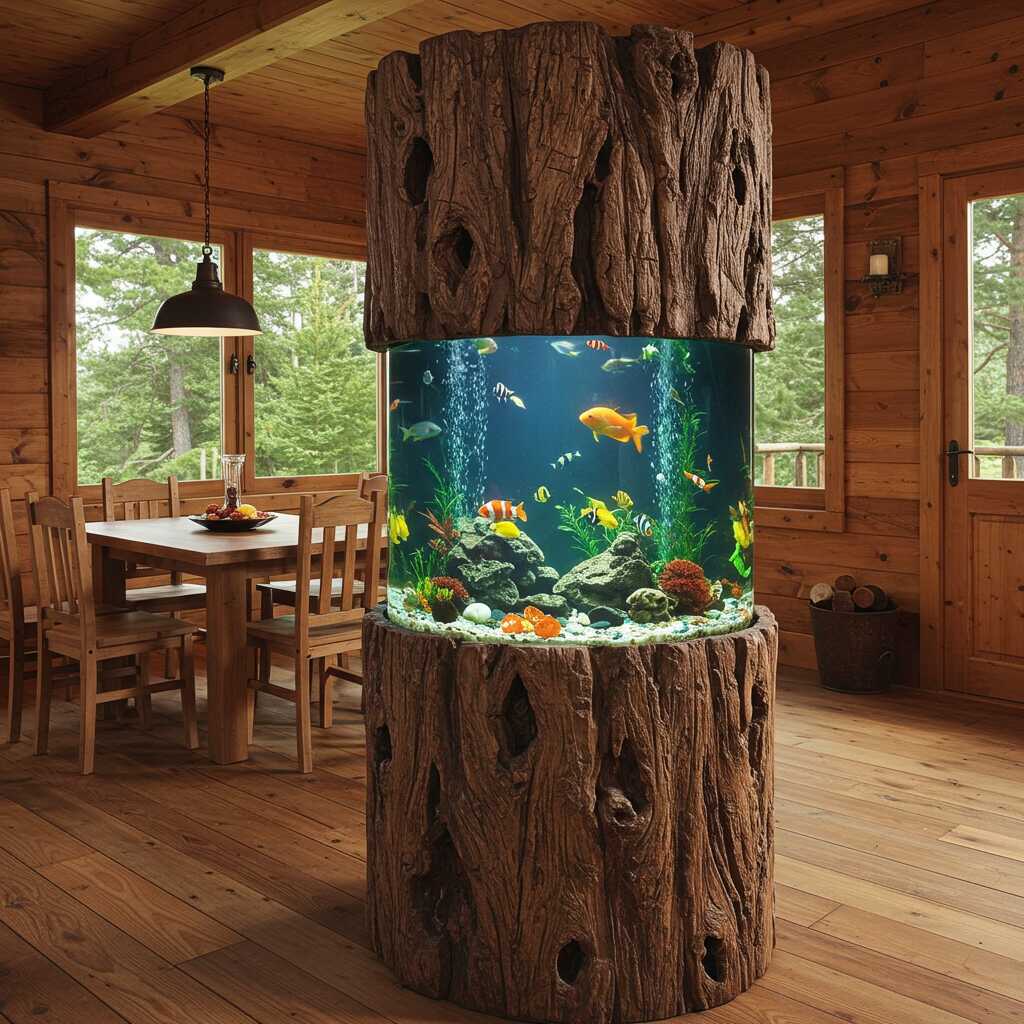
Philosophical Reflections: Humanity’s Place in the Natural World
The “Aquarium Integrated With Tree Trunk” transcends its physical form to become a profound philosophical statement about humanity’s relationship with the natural world. At its core, this design challenges the conventional dichotomy between human innovation and the environment, suggesting instead that the two can—and should—coexist in harmony. By embedding an aquatic ecosystem within the enduring frame of a tree trunk, these installations speak to a deeper truth: that nature is not a resource to be exploited but a partner in creation. They invite us to reconsider the narratives we construct about progress, urging a shift from domination to collaboration. In doing so, they offer a lens through which we can reflect on our responsibilities as stewards of the Earth and reimagine the ways in which we interact with the ecosystems that sustain us.
Philosophically, the tree trunk aquarium embodies the concept of interconnectedness, a principle central to many ecological and spiritual traditions. The design reminds us that no element of nature exists in isolation; every organism, every material, and every process is part of an intricate web of relationships. The tree trunk, once a living entity, continues to play a vital role long after its biological life has ended, providing shelter and sustenance for aquatic life. Similarly, the fish, plants, and microorganisms within the aquarium contribute to the health and vitality of the system, demonstrating how mutual dependence fosters resilience. This cyclical interplay mirrors the broader dynamics of the natural world, where death gives rise to new life and every action ripples outward to affect the whole. By embodying these principles, the tree trunk aquarium serves as a tangible metaphor for the interconnectedness of all life, challenging us to see ourselves not as separate from nature but as integral threads in its tapestry.
This design also prompts us to confront the ethical dimensions of human intervention in the natural world. While technological advancement has undeniably improved quality of life, it has often come at the cost of environmental degradation. The tree trunk aquarium offers an alternative vision—one where innovation enhances rather than diminishes the natural world. It exemplifies how creativity can align with ecological principles, creating solutions that are regenerative rather than extractive. This approach raises important questions about the values that guide human activity: Should progress be measured solely by economic or technological benchmarks, or should it also account for the well-being of the planet and its inhabitants? By presenting a model of design that prioritizes harmony over dominance, the tree trunk aquarium challenges us to redefine success in ways that honor the intrinsic worth of nature.
Furthermore, these installations evoke a sense of humility, reminding us of the transient and interconnected nature of existence. The tree trunk, with its weathered bark and visible imperfections, bears the marks of time and change, much like humanity itself. Its transformation into an aquarium speaks to the potential for renewal and reinvention, even in the face of decay. This narrative of transformation resonates deeply with the human experience, encouraging us to embrace impermanence and recognize the beauty in cycles of growth and decline. In doing so, the tree trunk aquarium inspires a sense of reverence for the natural world, fostering an ethic of care and respect that extends beyond the immediate context of the installation.
Ultimately, the “Aquarium Integrated With Tree Trunk” is more than an object of beauty or functionality—it is a call to action. It challenges us to rethink our role as creators and consumers, urging us to engage with the natural world in ways that are mindful, respectful, and sustainable. By bridging the gap between human ingenuity and ecological integrity, these installations offer a glimpse of what is possible when we approach the environment not as conquerors but as collaborators. They remind us that true innovation lies not in overcoming nature but in learning from it, working with it, and finding inspiration in its boundless wisdom. In this way, the tree trunk aquarium becomes a symbol of hope—a testament to the possibility of a future where humanity and nature thrive together in harmony.
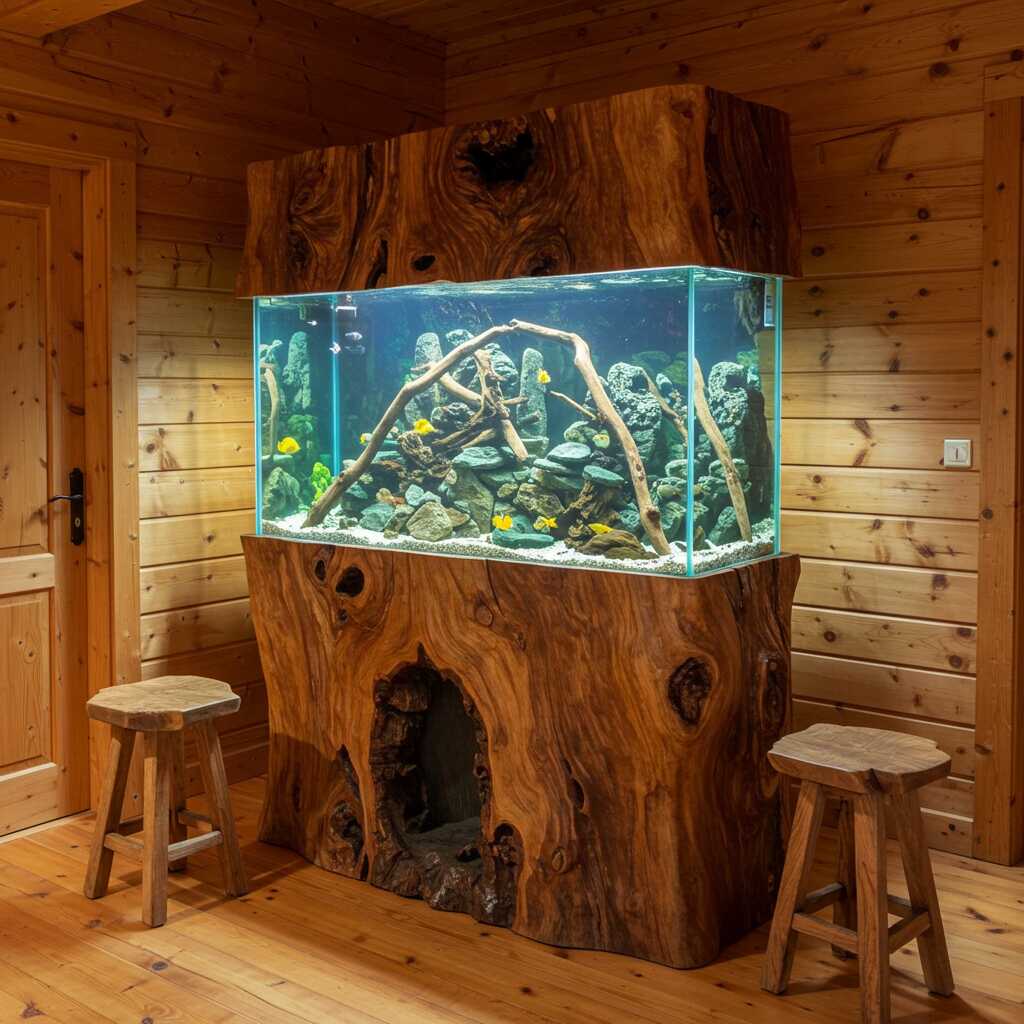
Conclusion: A Vision of Harmonious Coexistence
The “Aquarium Integrated With Tree Trunk” is far more than a mere design object; it is a profound embodiment of the intersection between nature and innovation. Through its seamless fusion of organic materials and human creativity, it challenges us to reimagine the boundaries between the natural and the artificial. These installations serve as reminders that true progress lies not in dominating the environment but in collaborating with it, honoring its rhythms and respecting its limits. By nurturing biodiversity, reducing waste, and inspiring ecological awareness, they exemplify how design can align with sustainability to create lasting value. Moreover, their philosophical resonance invites us to reflect on our place within the natural world, urging a shift from exploitation to stewardship. As symbols of interconnectedness and renewal, tree trunk aquariums embody a hopeful vision—a future where humanity and nature coexist in harmony, enriching one another in ways that are both profound and enduring.

